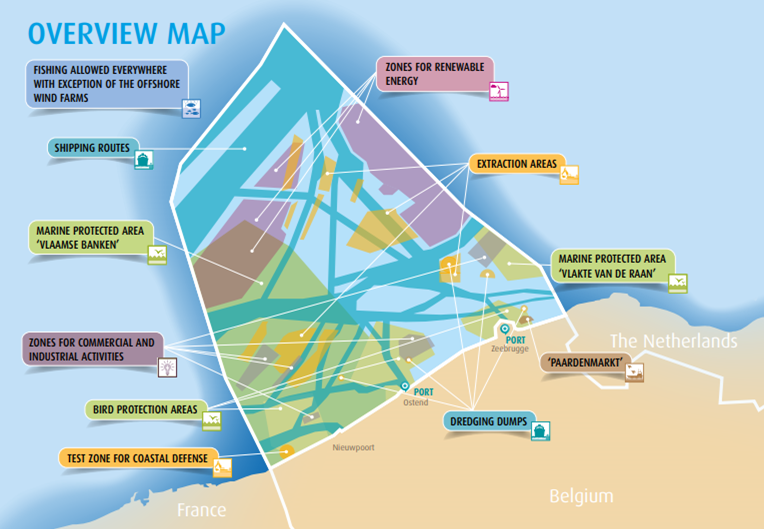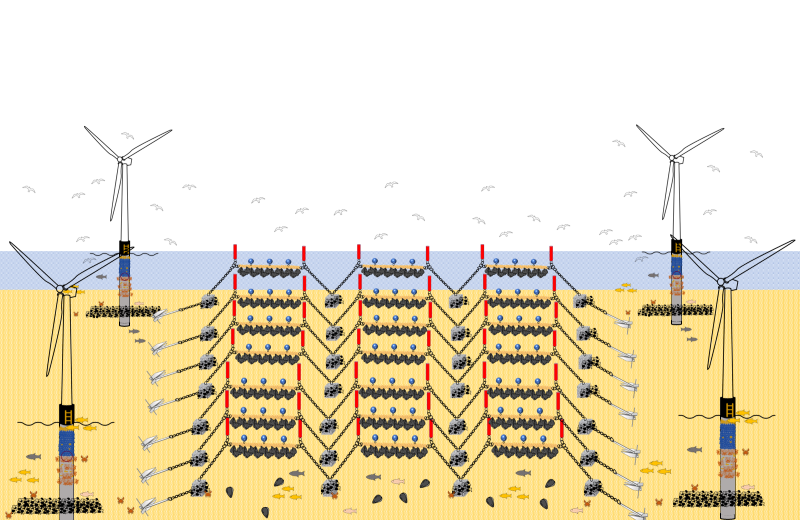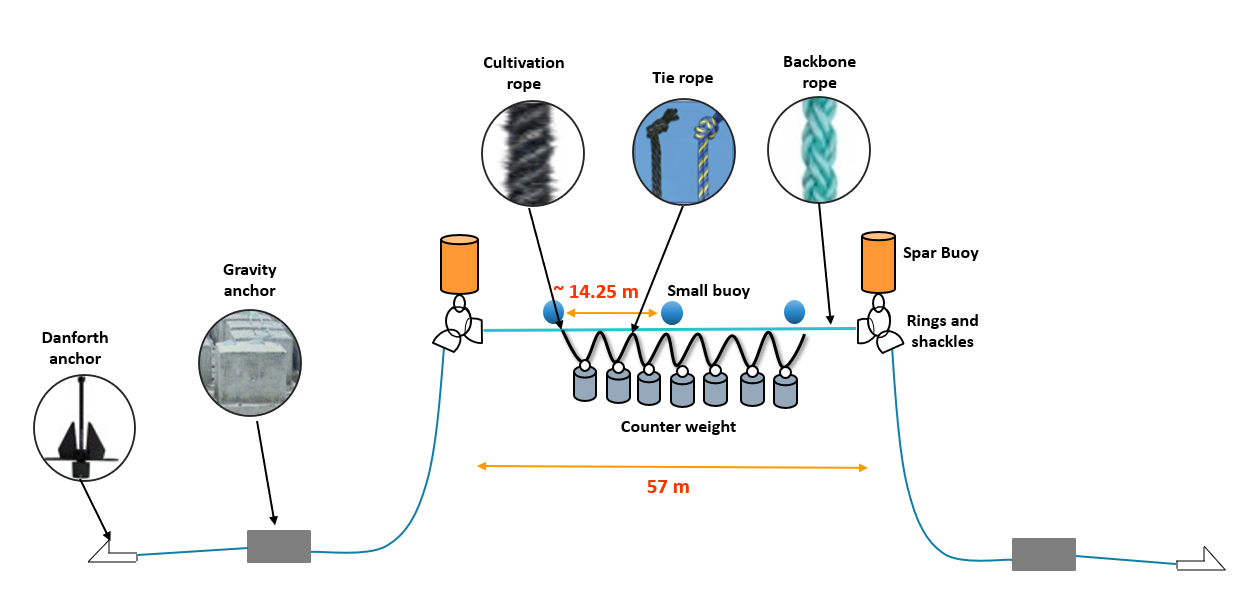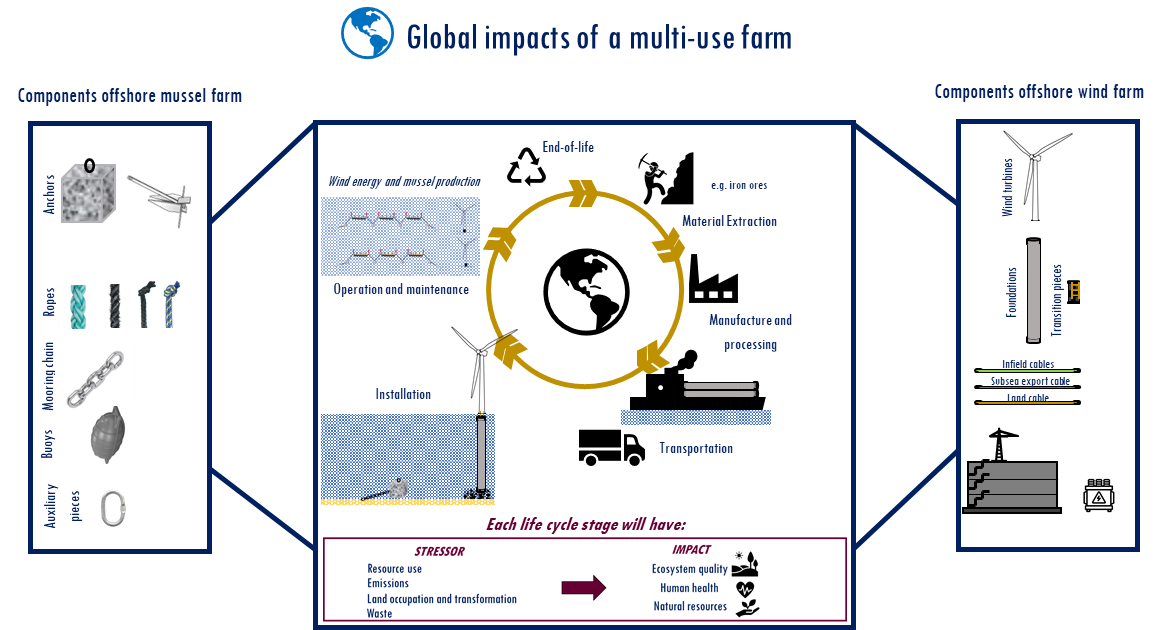What is marine multi-use?
The Belgian Continental Shelf (BCS) is a rather limited area covering 0.5% of the entire North Sea, but hosts a wide range of activities. In case activities can be ‘bundled’ in time and/or space (cfr. multi-use), this might be a promising solution for the continuity of these activities if we can simultaneously protect the marine environment (e.g. by minimizing or avoiding damages to the natural ecosystem or by the creation of co-benefits).
The Belgian Maritime Spatial Plan for 2020-2026 includes defined zones in the BCS where different marine activities can be operated jointly. All existing energy, cables, and pipelines zones are classified also as aquaculture development areas, which shows the intentions of future aquaculture integration into existing energy production zones. This spatial plan foresees that multiple use of space will become the general norm of use of space in the BCS by the year 2050.

Overview Map – The Belgian Marine Spatial Plan for 2020 – 2026. Source: Belgian Government (2020b).
The SUMES multi-use case combines two activities in the same geographical location in the Belgian Continental Shelf, namely hypothetical mussel farm into an existing offshore wind.

Why is multi-use of offshore mussel farming and wind energy relevant in Belgium?
Belgium is one of the leading countries in the offshore wind industry. The BCS hosts an installed capacity of 2.3 GW of offshore wind power generated through 9 OWFs, and this represents 10% of the electricity demand in Belgium. Also, in the new MSP for 2020-2026, a second area composed of three zones (classified as energy, cables, and pipelines zone) is reserved for new OWF installations, which would lead to a total installed offshore wind energy capacity of about 5.5 to 5.8 GW in the BCS.
Aquaculture, however, in the BCS is a modest and small-scale activity. The breeding possibilities are limited because there is a lack of e.g. bays and estuaries, and the coastline is used for many different activities. In the last decades, some R&D projects experimented with aquaculture, where mainly 'hanging cultivation' is used whereby ropes are connected to buoys. In the current MSP, only the zone for renewable energy is designated as a location for concessions for marine aquaculture. There are no specifications regarding the type of aquaculture that should be integrated. Fish cages might be difficult with the infrastructure today because it is not compatible with the limited depth of the BCS and the sub-optimal seasonal temperature values for targeted commercial fish species. Furthermore, offshore seaweed cultivation is a sector which is still in its infancy in this region and for which more applied research is recommended to understand its feasibility. Most of the projects in the EU region who evaluated aquaculture-OWF integration as a multi-use case have shown especially for mussel farming positive results (while for seaweed and fish aquaculture more research is needed). According to literature and based on the results of pilot tests performed in the BCS, especially blue mussel farming within OWFs seems promising. Therefore, integration of mussel farming in an existing OWF concession zone is selected as a multi-use case in SUMES.
What are the main components of the mussel farm?
A hypothetical mussel farm is designed since there is currently no full-scale mussel farming exploited in the BCS, and certainly not integrated within offshore wind farms. The SUMES multi-use case therefore builds upon public information from a previous pilot level study on the integration of mussel farming activities in existing offshore wind farms in the BCS (cfr. the EDULIS project). In addition, literature was explored and a series of expert meetings were held to finetune the setup and design of the hypothetical commercial mussel farm. It consists of multiple mussel farming lots (a group of mussel farming lines), and each lot is installed between four offshore wind turbine and includes 7 connected mussel cultivation rows (see Figure below). These rows consist of three longline systems connected to each other with shared anchors.

Own design, not scaled proportionality.
Furthermore, one longline is composed of backbone ropes, anchor blocks, mooring chains, cultivation ropes and auxiliary components for connecting the main elements. Backbone ropes are the main ropes which are installed horizontal (parallel to the sea surface) and these are connected and fixed to the sea bottom using anchors at both ends. Anchors are connected to the backbone through mooring chains. Cultivation ropes are the ropes on which mussels actually grow once mussel spats are settled. The cultivation rope in this case is a continuous rope which is connected to the backbone rope at several points providing multiple V-shapes. The weight of the system (longline system including mussels) is balanced by using buoys (SPAR buoys & intermediate buoys).

One longline system design of the Advanced Case Study (Adapted from Pribadi et al., 2019).
It is assumed that the lifetime of this mussel farm will be 12-years and depending on the collected data, it is predicted that the total amount of harvested mussels will be around ~4604 tonnes for the Belgian North Sea conditions.
Impacts of a multi-use offshore farm
A multi-use offshore farm which is an integration of an offshore wind farm and mussel farm can have local to global, both positive and negative impacts on ecosystems.
Regarding local effects, obviously, renewable electricity and mussels for food applications are beneficial effects. These are also considered as provisioning ecosystem services. However, these multi-use activities also alter other ecosystem services through changes in the local marine ecosystem and its functioning. For example, specifically for mussel aquaculture, alteration in the cycle of nitrogen are foreseen as they are filter feeding organisms. This in combination with the inclusion of hard substrates (wind turbines foundations) that serve as new habitats to different marine organisms, can lead to changes on marine biodiversity and biomass and eventually to the functioning of the marine ecosystem. All these changes in the marine ecosystem may ultimately affect the supply of ecosystem services, i.e. provisioning, regulating and cultural. To quantify these impacts, methodologies such as ecological risk assessment and ecosystem services assessment are needed. More information can be found in the “Ecosystem services model” section.
Global impacts on the other hand of the multi-use offshore farm relate to the value chain, considering all life cycle phases - starting from the raw material extraction to end of life treatment of the decommissioned components. Each of these life cycle stages will generate several stressors, such as emissions, land transformation and occupation, resource use and wastes, which eventually cause impacts on ecosystem quality (e.g. ecotoxicity, eutrophication, land-use change), human health (e.g. global warming, toxicity, radiation) and natural resources (e.g. depletion of mineral and fossil resources). For example, steel is the mostly used material to manufacture the components of an offshore wind farm, including the wind turbines and foundations. To produce steel, the extraction of iron ores is first needed and then the ores are transported to a steel manufacturing site to be processed. After the steel is produced, it is transported again to a wind turbine or foundation manufacturing site. All these processes will eventually generate different impacts. To quantify the impacts of the value chain, a life cycle assessment is usually conducted.
Furthermore, the environmental sustainability performance of offshore wind energy in combi with mussel farming is compared with another type of energy and food source (cfr a benchmark) to better understand its positioning relative to competitors. More information on the benchmark is found in our recent paper.
